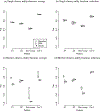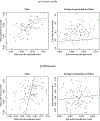Bayesian Nonparametric Policy Search with Application to Periodontal Recall Intervals
- PMID: 33012901
- PMCID: PMC7531024
- DOI: 10.1080/01621459.2019.1660169
Bayesian Nonparametric Policy Search with Application to Periodontal Recall Intervals
Abstract
Tooth loss from periodontal disease is a major public health burden in the United States. Standard clinical practice is to recommend a dental visit every six months; however, this practice is not evidence-based, and poor dental outcomes and increasing dental insurance premiums indicate room for improvement. We consider a tailored approach that recommends recall time based on patient characteristics and medical history to minimize disease progression without increasing resource expenditures. We formalize this method as a dynamic treatment regime which comprises a sequence of decisions, one per stage of intervention, that follow a decision rule which maps current patient information to a recommendation for their next visit time. The dynamics of periodontal health, visit frequency, and patient compliance are complex, yet the estimated optimal regime must be interpretable to domain experts if it is to be integrated into clinical practice. We combine non-parametric Bayesian dynamics modeling with policy-search algorithms to estimate the optimal dynamic treatment regime within an interpretable class of regimes. Both simulation experiments and application to a rich database of electronic dental records from the HealthPartners HMO shows that our proposed method leads to better dental health without increasing the average recommended recall time relative to competing methods.
Keywords: Dirichlet process prior; dynamic treatment regimes; observational data; periodontal disease; practice-based setting; precision medicine; sequential optimization.
Figures






Similar articles
-
A spatiotemporal recommendation engine for malaria control.Biostatistics. 2022 Jul 18;23(3):1023-1038. doi: 10.1093/biostatistics/kxab010. Biostatistics. 2022. PMID: 33838029 Free PMC article.
-
Interpretable Dynamic Treatment Regimes.J Am Stat Assoc. 2018;113(524):1541-1549. doi: 10.1080/01621459.2017.1345743. Epub 2018 Nov 14. J Am Stat Assoc. 2018. PMID: 30774169 Free PMC article.
-
Using decision lists to construct interpretable and parsimonious treatment regimes.Biometrics. 2015 Dec;71(4):895-904. doi: 10.1111/biom.12354. Epub 2015 Jul 20. Biometrics. 2015. PMID: 26193819 Free PMC article.
-
Routine scale and polish for periodontal health in adults.Cochrane Database Syst Rev. 2018 Dec 27;12(12):CD004625. doi: 10.1002/14651858.CD004625.pub5. Cochrane Database Syst Rev. 2018. PMID: 30590875 Free PMC article.
-
Bayesian inference for optimal dynamic treatment regimes in practice.Int J Biostat. 2023 May 17;19(2):309-331. doi: 10.1515/ijb-2022-0073. eCollection 2023 Nov 1. Int J Biostat. 2023. PMID: 37192544 Review.
Cited by
-
A spatiotemporal recommendation engine for malaria control.Biostatistics. 2022 Jul 18;23(3):1023-1038. doi: 10.1093/biostatistics/kxab010. Biostatistics. 2022. PMID: 33838029 Free PMC article.
-
Bayesian semiparametric model for sequential treatment decisions with informative timing.Biostatistics. 2024 Oct 1;25(4):947-961. doi: 10.1093/biostatistics/kxad035. Biostatistics. 2024. PMID: 38230584 Free PMC article.
-
A scoping review of studies using observational data to optimise dynamic treatment regimens.BMC Med Res Methodol. 2021 Feb 22;21(1):39. doi: 10.1186/s12874-021-01211-2. BMC Med Res Methodol. 2021. PMID: 33618655 Free PMC article.
-
Estimating optimal dynamic treatment strategies under resource constraints using dynamic marginal structural models.Stat Med. 2021 Oct 15;40(23):4996-5005. doi: 10.1002/sim.9107. Epub 2021 Jun 29. Stat Med. 2021. PMID: 34184763 Free PMC article.
-
CAPITAL: Optimal subgroup identification via constrained policy tree search.Stat Med. 2022 Sep 20;41(21):4227-4244. doi: 10.1002/sim.9507. Epub 2022 Jul 7. Stat Med. 2022. PMID: 35799329 Free PMC article.
References
-
- AAP (2001). Glossary of Periodontal Terms. American Academy of Periodontology, Chicago, IL, 4 edition.
-
- AAP (2005). American academy of periodontology task force report on the update to the 1999 classification of periodontal diseases and conditions. Journal of Periodontology 86, 835–838. - PubMed
-
- Axelsson P, Lindhe J, and Nystrom B (1991). On the prevention of caries and periodontal disease. Journal of Clinical Periodontology 18, 182–189. - PubMed
Grants and funding
LinkOut - more resources
Full Text Sources
Other Literature Sources
